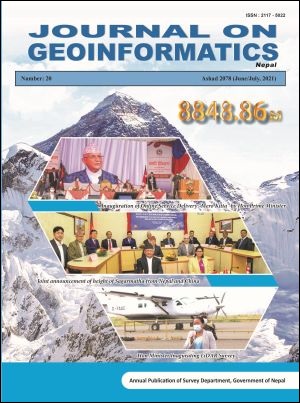Analyzing Urban Growth Pattern and Driving Factors Using Remote Sensing and GIS: A Case Study of Banepa Municipality, Nepal
DOI:
https://doi.org/10.3126/njg.v20i1.39471Keywords:
Urban Growth, Driving factors, Analytical Hierarchy Process (AHP)Abstract
Nepal is considered one of the rapidly urbanizing countries in south Asia. Most of the urbanization is dominated in large and medium cities i.e., metropolitan, sub-metropolitan, and municipalities. Remote Sensing and Geographic Information System (GIS) technologies in the sector of urban land governance are growing day by day due to their capability of mapping, analyzing, detecting changes, etc. The main aim of this paper is to analyze the urban growth pattern in Banepa Municipality during three decades (1992-2020) using freely available Landsat imageries and explore driving factors for change in the urban landscape using the AHP model. The Banepa municipality is taken as a study area as it is one of the growing urban municipalities in the context of Nepal. The supervised image classification was applied to classify the acquired satellite image data. The generated results from this study illustrate that urbanization is gradually increasing from 1992 to 2012 while, majority of the urban expansion happened during 2012-2020, and it is still growing rapidly along the major roads in a concentric pattern. This study also demonstrates the responsible driving factors for continuous urban growth during the study period. Analytical Hierarchy Process (AHP) was adopted to analyze the impact of drivers which reveals that, Internal migration (57%) is major drivers for change in urban dynamics whereas, commercialization (25%), population density (16%), and real estate business (5%) are other respective drivers for alteration of urban land inside the municipality. To prevent rapid urbanization in this municipality, the concerned authorities must take initiative for proper land use planning and its implementation on time. Recently, Nepal Government has endorsed Land Use Act 2019 for preventing the conversion of agricultural land into haphazard urban growth.




